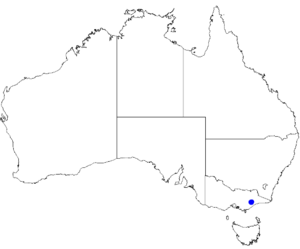Galbraith's boronia facts for kids
Quick facts for kids Galbraith's boronia |
|
|---|---|
| Conservation status | |
| Scientific classification | |
 |
|
| Occurrence data from Australasian Virtual Herbarium |
Boronia galbraithiae, often called the aniseed boronia or Galbraith's boronia, is a unique plant. It belongs to the citrus family known as Rutaceae. This plant is found only in a small area of Victoria, Australia.
It's a tall, woody shrub that smells a bit like fennel or aniseed. The plant has leaves made up of many smaller leaflets. It produces beautiful white to deep pink flowers, each with four petals. These flowers grow in small groups where the leaves meet the stem.
What Does it Look Like?
The aniseed boronia is a straight, woody shrub that can grow up to about 2 m (7 ft) tall. Its branches are smooth and have four distinct angles.
Its leaves are made up of many smaller leaflets, like a feather. Each leaf is about 12–30 mm (0.5–1 in) long and 5–14 mm (0.2–0.6 in) wide. The stem that holds the leaf is called a petiole, and it's about 4–9 mm (0.2–0.4 in) long. Each leaf has between seven and seventeen small leaflets. These leaflets are shaped like a spear or an egg, narrower at the base, and are mostly 2–9 mm (0.08–0.4 in) long and 1–3 mm (0.04–0.1 in) wide.
The flowers are white to deep pink. They usually grow in groups of three to five where the leaves meet the stem. Each flower sits on a small stalk called a pedicel, which is about 3.5–22 mm (0.1–0.9 in) long.
Each flower has four small, smooth, egg-shaped or triangular parts called sepals. These are about 1–2 mm (0.04–0.08 in) long. The four main petals are about 4.5–8 mm (0.18–0.31 in) long and 2.5–3.5 mm (0.098–0.14 in) wide. Inside the flower, there are eight hairy stamens, which produce pollen. The part that receives pollen, the stigma, is about the same width as its supporting stalk, the style.
This plant flowers in spring. After flowering, it produces a smooth, dry fruit called a capsule, which is about 4 mm (0.16 in) long.
How it was Named
The Boronia galbraithiae was officially described in 1993 by a scientist named David Edward Albrecht. He published his description in a science journal called Muelleria.
The second part of its scientific name, galbraithiae, was chosen to honor Jean Galbraith. She was the person who first discovered this plant species.
Where it Lives
The aniseed boronia grows in dry forests. You can find it near a place called Mount Difficult in East Gippsland, Victoria.
Looking After This Plant
The Boronia galbraithiae is considered "vulnerable." This means it's at risk of disappearing if we don't protect it. Both the Australian Government, under the Environment Protection and Biodiversity Conservation Act 1999, and the Victorian Government, under the Flora and Fauna Guarantee Act 1988, list it as vulnerable.
Because it's vulnerable, a special plan has been made to help it recover and survive. Some of the biggest dangers to this plant include:
- Fires: Fires that happen too often or not often enough can harm the plant's natural growth cycle.
- Roadworks: Building or maintaining roads can destroy its habitat.
- Forestry operations: Activities like logging in the forest can also threaten the plant.


